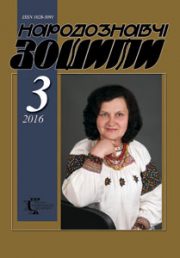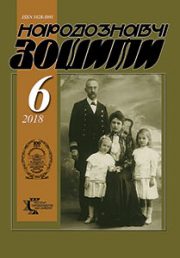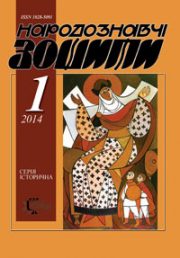The Ethnology Notebooks. 2019, 1 (145), 208—213
UDK 39874.4 78.085.7 (477)
DOI https://doi.org/10.15407/nz2019.01.208
FABRYKA-PROTSKA Olga
ORCID iD 0000-0001-5188-1491
Candidate of the Art critic, docent
Department of Musical Ukrainian,
Studies and Folk Instrumental Music Art
Institute of Art of the Precarpathian National University
after Vasil Stefanyk,
34-A, Academician Sakharov str., 76014,
Ivano-Frankivsk, Ukraine
Contacts: e-mail: olgafp4@ukr.net
Abstract. The article represents the specifics of the folklore festivals of the Ukrainian western frontier. The study of the specifics of the functioning of border boundaries has an interdisciplinary character.
The issue covers art and culture, religion and language, politics and ideology. The issue of the borderline nowadays highlights a number of aspects of the modern interaction of many ethnic cultures on the level of assimilation, migration and interactions that are related to the history and residence in one territory of several neighboring nations and, forced and voluntary migration of Ukrainians to European countries etc.
For today, the course and features of the folk festivals of the border areas are still little studied in the scientific circle.
During the period of independence of Ukraine, it was found that due to certain reasons of socio-cultural, economic and political nature, the dynamics of the festival movement also changed. The folk festival combines the traditional principles of presentation, revival, recreation of deep sacral and mental phenomena of the ethnos, and spectacular — in the inherent festival of the character of the action.
This event is a holiday for both performers and spectators who become direct collaborators of the process of deploying festival forms.
The components of the genres of folk festivals include: vocal solo, ensemble, choral; instrumental — solo, ensemble, orchestra; vocal-instrumental — solo and ensemble. Folklore festivals are distinguished by their specialty (amateur, professional or synthesized), according to age characteristics and genre typology.
The complex levels of interaction of intercultural communication among representatives of different ethnic groups are developing, in particular: the formation of knowledge and skills about the musical traditions of certain ethnic groups and subethnos, their functioning and distribution, signs of transformation.
Among the functions of folk musical instruments, presenting their art at folklore festivals, one should name the identification (national, ethnic, subethnic); anthropological; informational; cognitive; value-aesthetic; entertaining (to dance, to listening as an accompaniment); emotional, etc.
Keywords: ethnos, subethnos, frontier, musical folklore, song creation, festival, assimilation.
Received 22.12.2018
REFERENCES
Beregova, O. (2006). Komunikatsiya v sotsiokul’turnomu prostori Ukrayiny, tekhnolohiya chy tvorchist’? Kiev: NMAU im. P.I. Tchaikovskoho [in Ukrainian].
Dutczak, W., & Lipelt Robert. (Ed.). (2018) Suchasni fol’klorni festyvali na zakhidnomu pohranychchi Ukrayiny v konteksti mizhkul’turnoyi komunikatsiyi. Panstwowa Wyzza Szkola Zawodowa im. Jan Grodka w Sanok. Sanok [in Poland].
Karas, G. (2012). Muzychna kul’tura ukrayins’koyi diaspory u svitovomu chasoprostori XX stolittya: monohrafiia. Ivano-Frankivsk: Typovyt [in Ukrainian].
Kochan, V. (2008). Fenomen pohranychchya u sotsiokul’turnomu vymiri: avtoref. dys. na zdobuttia nauk. stupenia kand. filos. nauk. Simferopol, 2008 [in Crimea].
Sichova, O. (2015). Mystets’ki festyvali v sotsiokul’turnomu prostori malykh i serednikh mist suchasnoyi Ukrayiny: dys.… kand. mystetstvoznavstva: 26.00.01 (teoriia ta istoriia kul’tury). Kyiv, 2015 [in Ukrainian].
Sukhomlinov, O. Kul’turni pohranychchya: novyy pohlyad na staru problemu. Donetsk: Yuho-Vostok Ltd. [in Ukrainian].
Fabryka-Protska, O. (2013). Pisenna kul’tura lemkiv Ukrayiny (XX—XXI st.): monohrafiia. Ivano-Frankivsk: Nova Zora [in Ukrainian].
Chaplik, K. (2013). Ekzystentsiya lemkivs’kykh pereselentsiv v umovakh suchasnoyi Ukrayiny: monograph. Kyiv: Vydavnychyj dim Dmytra Buraho [in Ukrainian].
Chernetska, S. (2015). Festyvali fol’kloru v sotsiokul’turnykh protsesakh Ukrayiny kintsya XX — pochatku XXI stolittya: dys. …kand. mystetstvoznavstva: 26.00.01 (teoriia ta istoriia kul’tury). Kyiv [in Ukrainian].






